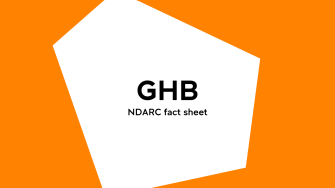15 May 2025
NDARC fact sheet:
GHB
GHB

GHB (gamma-hydroxybutyrate) is a central nervous system depressant, which means it slows down the messages travelling between the brain and the body. Although it is sometimes called liquid ecstasy, it is not chemically related to ecstasy and has an entirely separate chemical profile and effects.
GHB usually comes as a liquid, and is sold in vials, bottles or fish-shaped soy sauce containers. It is colourless but may have colour added (often blue) to stop it being mistaken for water or other clear liquids. It is odourless and can have either a bitter or a salty taste. Less often, GHB is found in the form of a white powder. GHB is usually swallowed but may be injected, snorted or inserted anally.
The initial effects of GHB occur between 15 and 20 minutes after oral administration, with peak effects occurring between 30 and 60 minutes post-ingestion. The effects of GHB can last for up to three hours, or even longer if large doses have been consumed.
The short-term effects of GHB include:
There is a real risk of overdose. Signs of acute GHB toxicity include agitation, excitation, respiratory depression, respiratory arrest, coma, vomiting and seizures.
Of particular concern is the combination of GHB with other drugs, especially other depressants, such as alcohol or benzodiazepines, which increase the risk of adverse events. Injury may also occur due to confusion, dizziness, or an abrupt loss of consciousness.
Overdosing is a serious danger with GHB. The chemical composition of GHB is highly variable. It is very easy to take too much GHB and the difference between the amount needed to get high and the amount that causes an overdose can be hard to judge.
Serious adverse effects can include sudden sedation and respiratory distress. Analysis of different vials of GHB has shown that the concentration varies considerably, so users can never be sure of how much they are taking.
A study conducted by the National Drug and Alcohol Research Centre (NDARC) at UNSW Sydney examining deaths attributable to GHB in the National Coronial Information System found that the typical case was a young male, who swallowed GHB and used it with other substances, most commonly at home. While acute drug toxicity was the most common cause of death, there was a substantial minority due to trauma or suicide.
When GHB is mixed with other depressants, such as alcohol or benzodiazepines, it increases the depressant effects of both drugs, which may lead to respiratory distress and even death. Small doses of GHB are potentially very potent, and when combined with alcohol or methamphetamines, the risk of overdose is greatly increased.
A GHB dependence syndrome has been recognised by clinicians since the early 1990s. Tolerance to GHB develops rapidly, leading to dose escalation and more frequent use.
There is a potentially severe withdrawal syndrome that is a strong motivator to maintain use. The onset of withdrawal occurs between six and 72 hours after last use and may last five to 15 days.
Withdrawal symptoms include:
GHB withdrawal is often associated with symptoms of anxiety and restlessness. Symptoms typically manifest within 24 hours of last consumption. Hallucinations are also reported, most commonly visual and auditory. Delirium, delusions and paranoia, and psychosis in the absence of delirium, have all also been reported.
Evidence from better-researched drugs suggests that services providing good social support, as well as psychological interventions to help maintain motivation and improve coping skills, may be effective.
According to the Australian Institute of Health and Wellbeing, around 0.2% of the population, or 40,000 people, reported recent use of GHB in the 2022-2023 National Drug Strategy Household Survey. This represents 0.1% increase compared to the reported use in 2019.
The Illicit Drug Reporting System (IDRS) is an Australian monitoring system run by the National Drug and Alcohol Research Centre (NDARC) at UNSW Sydney that identifies emerging trends of local and national concern in illicit drug markets.
The Ecstasy and Related Drugs Reporting System (EDRS) is an Australian monitoring system run by NDARC that identifies emerging trends of local and national interest in ecstasy and related drug use, markets and harms.
The Pocket Guide to Drugs and Health is a publication authored by experts from NDARC that provides information for health professionals on the impact of drug use.
The Australian Institute of Health and Welfare collects information on alcohol and tobacco consumption, and illicit drug use among the general population in Australia.
The Australian Bureau of Statistics is Australia’s national statistical agency, providing official statistics on a range of economic, social, population and environmental matters of importance to Australia.
Alcohol and Drug Foundation (2024). GHB. Retrieved from: adf.org.au/drug-facts/ghb/
Australian Institute of Health and Welfare (2024) National Drug Strategy Household Survey 2022–2023. AIHW, Australian Government. Retrieved from: aihw.gov.au/reports/illicit-use-of-drugs/national-drug-strategy-household-survey/data
Darke, S., Lappin, J., & Farrell, M. (2024). The Clinician’s Guide to Illicit Drugs and Health (Revised Edition); London: Silverback Publishing.
Darke, S., Peacock, A., Duflou, J., Farrell, M., & Lappin, J. (2020). Characteristics and circumstances of death related to gamma hydroxybutyrate (GHB). Clinical Toxicology, vol. 58, no. 11, pp. 1028–1033. Retrieved from: doi.org/10.1080/15563650.2020.1726378
Swift, W., Nielsen, S., Kaye, S., et al (2017). A Quick Guide to Drugs & Alcohol. Third Edition. Drug Info, State Library of New South Wales.
If you, or someone around you, is experiencing undesired or distressing psychological or physical symptoms from the intake of alcohol or other drugs, please seek immediate medical attention.
If you need urgent help from ambulance services, call Triple Zero (000). If a person has been mixing drugs with alcohol or other drugs, tell the paramedic exactly what has been taken.
For free and confidential advice about alcohol and other drugs, call the National Alcohol and Other Drug Hotline on 1800 250 015. The hotline will automatically direct you to the Alcohol and Drug Information Service in your state or territory.
15 May 2025
Fact Sheets
NDARC
Download this resource